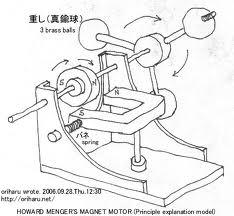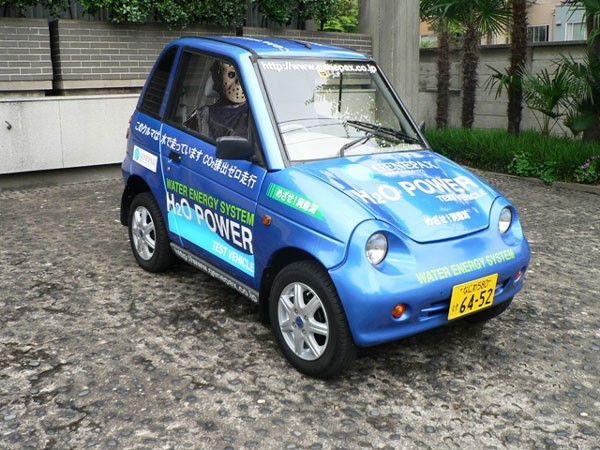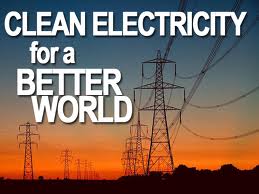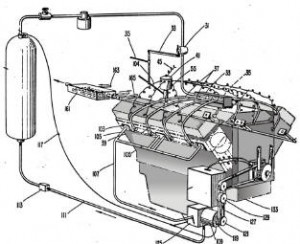In this the fifth post in my series I will introduce some of the inventions that claim to produce free and/or pollution free energy. I would like to make it clear from the outset however that I do not know whether these techniques actually work. Many of them have been patented, some replicated and some demonstrated several times. Some defy the accepted laws of physics. Some have been proven false.
The following examples are just a few drawn from dozens found on the internet.
The patenting of machines that claim to harness energy directly from the atmosphere has a long history. At the turn of the 20th century Nikola Tesla registered several patents for inventions of this type. One particularly simple device is known as his ‘aerial device’. It is something like a large insulated sheet of metal with a capacitor and transformer attached below it. The metal plate vibrates, possibly due to static and the capacitor is charged. The transformer lowers the voltage and the current can be fed into the system. It works day and night and the size of the metal sheet determines how much power is produced. Tesla’s biography is here. As you see he was not a crank, without his work we would probably not have computers today.
Tesler’s invention might be described as producing free energy, and this is certainly one aim for inventors of these types of objects. Another objective however is to build a machine that produces more power than it uses to operate it. Simple enough, I use 10 units of power to make the machine work, and the machine provides me with 11 units of output, or more. There are several machines that claim to succeed in this goal. It even tells you how easy each project is to construct, how well it is likely to work and how reliable the ideas upon which it is based are.
First to free energy. The internet is full of demonstrations of magnet motors and how to build them. This video is an example. The builders claim that using only magnets they can build a motor that spins without any external force being applied. A quick search will find plans and detailed explanations of materials needed and results expected. The only problem seems to be that the results are ‘physically unexplainable’ and many people say impossible. Are these machines fraudulent? I would love to know, because if they are not then it looks like clean electricity is possible today.
Other systems involve using different types of fuel from those conventionally thought of. A current example is the claim made about recent successes in what we in the non-science world call ‘cold fusion’ and is correctly termed a low energy nuclear reaction.
Early last year engineer Andrea Rossi and Physicist Sergio Focardi built a machine in Bologna Italy that they claim can produce huge amounts of power without polluting or causing radiation using only nickel as a fuel. The nickel is turned to copper during the process (proof of a nuclear reaction taking place) but only tiny amounts of fuel are used. There is however an undisclosed secret ingredient to the operation, and Rossi will not divulge his secret to anyone, including Focardi. The two demonstrated the machine on at least 2 separate occasions last year and are currently constructing a huge version for trials later this year. See this article on the Bassetti Foundation website for a fuller explanation and links to a video of their demonstration.
The water powered car is another thing to look at, and has been in existence for many years. There are several videos on the Internet demonstrating converted internal combustion engines that run on water. In this video inventor Paul Pantone demonstrates his “GEET Plasma Reactor Motor”, explaining how it works and showing it running. Here we get into conspiracy territory however, as the video states that after posting the video on Youtube the inventor was arrested and denied medical therapy while under arrest. There is an implicit claim that those in authority did not want his invention to be made public, but this is not backed up by any evidence however.
A related story is of the guy who invented a car that ran on water in the 1980’s. Stanley Meyer built a sort of dune buggy and the Pentagon reportedly showed interest in his invention. He died in strange circumstances however in a car park outside a restaurant in Ohio in 1998, probably poisoned. Some (as this video demonstrates), go as far as to say that he was murdered by the state but again without providing evidence, but the conspiracies abound once more. Several other sites claim that his car was then stolen along with all of his plans and technology, although there are several long videos and rediscovered tapes on Youtube in which he explains how the car works. As the photo below demonstrates, modern versions do exist today. This water powered car was built in Japan, watch the video on this website.
And here to the thorny matter, many of these machines are available to buy today, well the plans are at least. The Hojo motor promises free electricity for example, but at a price, and what if you buy the plans to discover that you can’t get the thing to run?
This article describes how the Federal Trade Commission investigated allegedly false claims by a well-known inventor and character in this field named Denis Lee. They found that the promoters ‘are marketing a product that cannot exist and function as claimed’ and allowed complaints to be filed. Pseudo-science and marketing at its best we might say.
If you want to read more about these devices the free energy website will keep you occupied for days. Chapter 16 should be your stating point.
I would love to hear from anyone that has either constructed or seen any of these machines in real life. Next week I will conclude the series so speak now, of forever hold your peace!





